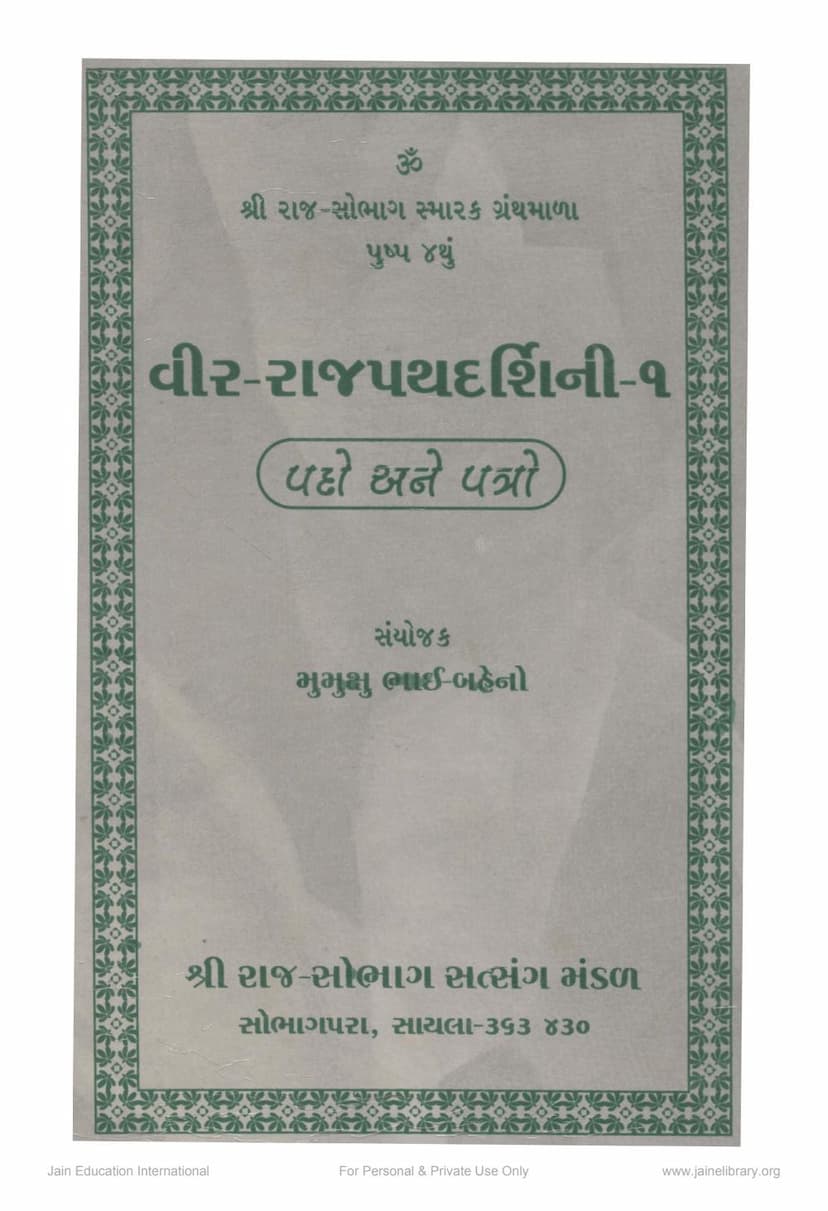Veer Raj Pathdarshini 01
Added to library: September 2, 2025

Summary
Here's a comprehensive summary of the Jain text "Veer Raj Pathdarshini 01," based on the provided pages:
Title: Veer Raj Pathdarshini - 1 (Collection of Poems and Letters) Author: Compiled by Mumukshu Brothers and Sisters Publisher: Shri Raj-Saubhagya Satsang Mandal, Sayla Series: Shri Raj- Volume: Pushpa 4th (Fourth Flower)
Overall Purpose: This book is presented as the fourth publication in the "Shri Raj-Saubhagya Smarak Granthamala" series by Shri Raj-Saubhagya Satsang Mandal, Sayla. Its primary purpose is to guide seekers on the spiritual path ("Veer Raj Pathdarshini" - The Path of the Heroic King/Lord). It aims to provide spiritual guidance and upliftment to those on the path of liberation (moksha).
Content Breakdown:
The book is divided into several sections, primarily featuring spiritual poetry (pado) and spiritual correspondence (letters):
-
Pado (Poems) by Param Kripalu Shrimad Rajchandra Dev: This section contains numerous poems attributed to Shrimad Rajchandra, a revered Jain spiritual figure. These poems cover a wide range of spiritual themes, including:
- Devotional Salutations: Poems offering respect and prayers to monks and the divine.
- Philosophical Reflections: Ponderings on the nature of birth, aging, death, time, impermanence (anitya), the feeling of being without refuge (asharan), oneness (ekattva), otherness (anyattva), and impurity (ashuchi).
- Moral and Ethical Teachings: Emphasis on dharma, virtuous conduct, self-control, detachment, discrimination between the self and the non-self (jiva and pudgala), the importance of renunciation, and the impermanence of worldly possessions and status.
- Praise of the Tirthankaras: Specific stutis (hymns) dedicated to Tirthankaras, particularly Rishabhdev and Shantinath.
- The Nature of True Religion: Highlighting compassion (daya) as the essence of all religions, truthfulness, chastity (brahmacharya), and righteous living.
- The Power of Devotion: Stressing the importance of devotion to the Tirthankaras and the Guru for spiritual progress and overcoming worldly suffering.
- Critique of Materialism and Worldly Pursuits: The poems often contrast the futility of seeking happiness in worldly possessions, power, and sensual pleasures with the lasting peace found in spiritual realization.
- The Nature of Desire (Trushna): Illustrating the insatiable nature of worldly desires through vivid imagery.
- The Importance of the Guru: Underscoring that true knowledge and spiritual progress are unattainable without the guidance of a Guru.
- The Path to Liberation (Moksha): Discussing concepts like knowledge (gyan), meditation (dhyan), dispassion (vairagya), and the ultimate goal of self-realization.
-
Selected Pado by Other Saints: This section includes poems from other respected spiritual figures, such as:
- Shridhanandji Maharaj
- Anandghanji Maharaj
- Chhotam
- Yashovijayji Maharaj
- Kalidasbhai: Poems marking significant milestones in the spiritual journey.
-
Aath Drishti ni Sajhay with Bhavarth (Commentary on Eight Perspectives) by Mahopadhyay Yashovijayji: This is a significant section featuring Yashovijayji's work, which Shrimad Rajchandra reportedly called a "thermometer for measuring the soul's state." The commentary explains eight spiritual perspectives crucial for understanding the soul's condition and progress. The text emphasizes that these perspectives are progressive, leading from initial spiritual inclination to deeper realization. The commentary provides a detailed explanation of each perspective, its associated virtues and vices, and its role in the spiritual journey.
-
Spiritual Correspondence (Adhyatmik Patra Vyavahar): This extensive section comprises letters exchanged between:
- P.P. Shri Sadgurudev (Bapu ji) and Brahm Nishth Shri Sadgunaben.
- This correspondence serves as a practical guide to spiritual practice, detailing the seeker's (Sadgunaben's) journey, doubts, questions, and the Guru's (Bapu ji's) insightful guidance. The letters reveal a deep spiritual dialogue covering:
- Understanding of Jain Philosophy: Discussions on concepts like soul, karma, liberation, spiritual practices, and the nature of reality.
- Practical Guidance: Advice on meditation, dealing with worldly distractions, overcoming obstacles in spiritual practice, and maintaining equanimity.
- The Guru-Disciple Relationship: Highlighting the importance of the Guru's role in guiding the disciple and the disciple's complete surrender and devotion.
- Personal Spiritual Progress: Sadgunaben's candid sharing of her spiritual experiences, challenges, and progress, which serves as an inspiration and a practical manual for other seekers.
- The Importance of Scripture and Study: The letters often refer to various scriptures and the need for diligent study and contemplation.
Key Themes and Messages:
- The Ultimate Goal of Liberation (Moksha): The central theme is the pursuit of liberation from the cycle of birth and death through spiritual practice.
- The Centrality of the Self (Soul): The texts consistently point towards the soul (Atma) as the true self, distinct from the physical body and worldly attachments.
- The Path of Renunciation and Detachment: A strong emphasis is placed on detachment from worldly pleasures, possessions, and relationships as a means to spiritual progress.
- The Crucial Role of the Guru: The Guru is presented as indispensable for true spiritual understanding and guidance.
- The Importance of Right Conduct and Knowledge: Living a virtuous life, practicing non-violence, truthfulness, and cultivating right knowledge are paramount.
- The Power of Discrimination (Viveka): The ability to discern between the eternal self and the transient world is vital for spiritual advancement.
- Perseverance in Sadhana: The journey requires constant effort, patience, and unwavering devotion.
- Spiritual Transformation: The letters, in particular, illustrate the transformative power of spiritual guidance and practice.
Overall Significance: "Veer Raj Pathdarshini - 1" appears to be a collection of profound spiritual teachings and personal spiritual journeys within the Jain tradition, particularly influenced by the teachings of Shrimad Rajchandra. It aims to provide practical guidance, philosophical insights, and devotional inspiration to spiritual aspirants. The inclusion of personal correspondence offers a unique and intimate glimpse into the Guru-disciple relationship and the process of spiritual growth. The book is a valuable resource for those seeking to understand and practice Jain spirituality.